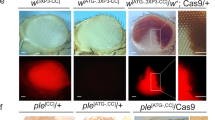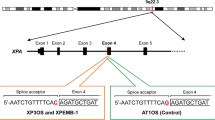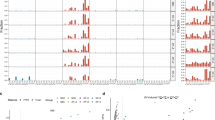Summary
The construction of permanent hybrid cell lines between xeroderma pigmentosum (XP) cells from different complementation groups allows analysis not only of the degree of repair correction but also of the restoration of biological activity to the UV-irradiated cells. With use of an immortal human cell line (HD2) that expresses excision repair defects typical of XP group D, a series of permanent hybrid cells has been produced with XP cells from groups A to H. Excision repair, as measured by incision analysis and unscheduled DNA synthesis, is restored to normal or near normal levels in crosses involving HD2 and cells from XP groups A, B, C, E, F, G, and I. All these hybrids show complementation for the recovery of normal UV restistance. As expected, hybrids expressing poor incision and hypersensitivity to UV were produced in crosses between HD2 and XPD fibroblasts, but they were also produced without exception when XPH was the partner. In the permanent HD2 x XPD or XPH hybrids, analysis of incision capacity reveals abnormally low activity and therefore that there has been no complementation. The true hybrid nature of HD2 x XPH cells has been confirmed by HL-A and -B tissue typing; moreover, detailed kinetic analysis of incision in these cells shows that the XPH phenotype, rather than the XPD, is expressed, i.e. breaks accumulate at low UV fluence of 1 J/m2. To help confirm these findings, another immortal XPD cell line was used in fusions involving HD2, XPH, or XPI. Cells resistant to ultraviolet were produced only with XPI fibroblasts. These data are discussed in terms of whether XPD and H mutations are likely to be allelic with respect to incision.
Similar content being viewed by others
References
Arrand JE, Bone NM, Squires S, Johnson RT (1988) Isolation of hamster DNA sequences which partially restore excision repair in xeroderma D cells. In: Friedberg EC, Hanawalt PC (eds) Mechanisms and consequences of DNA damage processing. Liss, New York, pp 319–324
Cleaver JE (1983) Xeroderma pigmentosum. In: Stanburg JB, Wyngaarden JB, Fredrickson DS, Goldstein JL, Brown MS (eds) The metabolic basis of inherited disease, 5th edn. McGraw-Hill, New York, pp 127–1243
Day RS III, Kraemer KH, Robbins JH (1975) Complementing xeroderma pigmentosum fibroblasts restore biological activity to UV-damaged DNA. Mutat Res 28:251–255
Downes CS (1984) Approaches to the quantitative analysis of repair through the use of inhibitors. Nucleic Acids Symp Ser 13:231–254
Elliott GC, Johnson RT (1985) DNA repair in mouse embryo fibroblasts. II. Responses of nontransformed, preneoplastic and tumorigenic cells to ultraviolet irradiation. Mutat Res 145:185–194
Fischer E, Keijzer W, Thielmann HW, Popanda O, Bohmert E, Edler L, Jung EG, Bootsma D (1985) A ninth complementation group in xeroderma pigmentosum, XP-I. Mutat Res 145:217–225
Giannelli F, Pawsey SA, Avery JA (1982) Differences in patterns of complementation of the more common groups of xeroderma pigmentosum: possible implications. Cell 29:451–458
Hsu SH, Schacter BZ, Delaney NL, Miller TB, McKusick VA, Kennett RH, Bodmer JG, Young D, Bodmer WF (1976) Genetic characteristics of the HeLa cell. Science 191:392–394
Johnson RT, Squires S, Elliott GC, Koch GLE, Rainbow AJ (1985) Xeroderma pigmentosum D-HeLa hybrids with low and high ultraviolet sensitivity associated with normal and diminished DNA repair ability, respectively. J Cell Sci 76:115–133
Johnson RT, Squires S, Elliott GC, Rainbow AJ, Koch GLE, Smith M (1986) Analysis of DNA repair in XP-HeLa hybrids; lack of correlation between excision repair of UV damage and adenovirus reactivation in an XP(D)-like cell line. Carcinogenesis 7:1733–1738
Kennett RH, Hampshire B, Bengtsson B, Bodmer WF (1975) Expression and segregation of HL-A antigens in D98/AH-2 by lymphocyte and fibroblast hybrids. Tissue Antigens 6:80–92
Lafforet D, Dupuy J-M (1978) Photosensibilité et réparation de l'ADN. Possibilité d'une parente nosologique entre xeroderma pigmentosum et syndrome de Cockayne. Arch Fr Pediatr [Suppl] 35:65–74
Laundy GJ, Raffoux C, Schreuder GMT, Klouda RT (1984) Antigen report: HLA-BW70, HLA-BW71, and HLA-BW72. In: Albert ED, Baur MP, Mayr WR (eds) Histocompatibility testing 1984. Springer, Berlin Heidelberg New York, p 173
Lehmann AR (1982) Three complementation groups in Cockayne's Syndrome. Mutat Res 106:347–356
Lehmann AR, Kirk-Bell S, Mayne L (1979) Abnormal kinetics of DNA synthesis in ultraviolet light-irradiated cells from patients with Cockayne's syndrome. Cancer Res 39:4237–4241
Moshell AN, Ganges MA, Lutzner MA, Coon HG, Barrett SF, Dupuy J-M, Robbins JH (1983) A new patient with both xeroderma pigmentosum and Cockayne syndrome establishes the new xeroderma pigmentosum complementation group H. In: Friedberg EC, Bridges BA (eds) Cellular responses to DNA damage. Liss, New York, pp 209–213
Paterson MC (1982) Accumulation of non-photoreactivable sites in DNA during incubation of UV-damaged xeroderma pigmentosum group A and group D cells. Prog Mutat Res 4:183–192
Paterson MC, Lohman PHM, Westerveld A, Sluyter ML (1974) DNA repair monitored by an enzymatic assay in multinucleate xeroderma pigmentosum cells after fusion. Nature 248:50–52
Rao PN, Johnson RT (1972) Cell fusion and its application to studies of the cell cycle. In: Prescott DM (ed) Methods in cell physiology, vol 5. Academic Press, London New York, pp 76–126
Robbins JH, Kraemer KH, Lutzner MA, Festoff BW, Coon HG (1974) Xeroderma pigmentosum, an inherited disease with sun sensitivity, multiple cutaneous neoplasms, and abnormal DNA repair. Ann Intern Med 80:221–248
Squires S, Johnson RT (1988) Kinetic analysis of UV-induced incision discriminates between fibroblasts from different xeroderma pigmentosum complementation groups, XPA heterozygotes and normal individuals. Mutat Res 193:181–192
Squires S, Johnson RT, Collins ARS (1982) Initial rates of DNA incision in UV-irradiated human cells: differences between normal, xeroderma pigmentosum and tumour cells. Mutat Res 95:389–404
Terasaki PI, McClelland JD (1964) Microdroplet assay of human serum cytotoxins. Nature 204:998
Weerd-Kastelein EA de, Kleijer WJ, Sluyter ML, Keijzer W (1973) Repair replication in heterokaryons derived from different repairdeficient xeroderma pigmentosum strains. Mutat Res 19:237–243
Author information
Authors and Affiliations
Rights and permissions
About this article
Cite this article
Johnson, R.T., Elliott, G.C., Squires, S. et al. Lack of complementation between xeroderma pigmentosum complementation groups D and H. Hum Genet 81, 203–210 (1989). https://doi.org/10.1007/BF00278989
Received:
Revised:
Issue Date:
DOI: https://doi.org/10.1007/BF00278989




